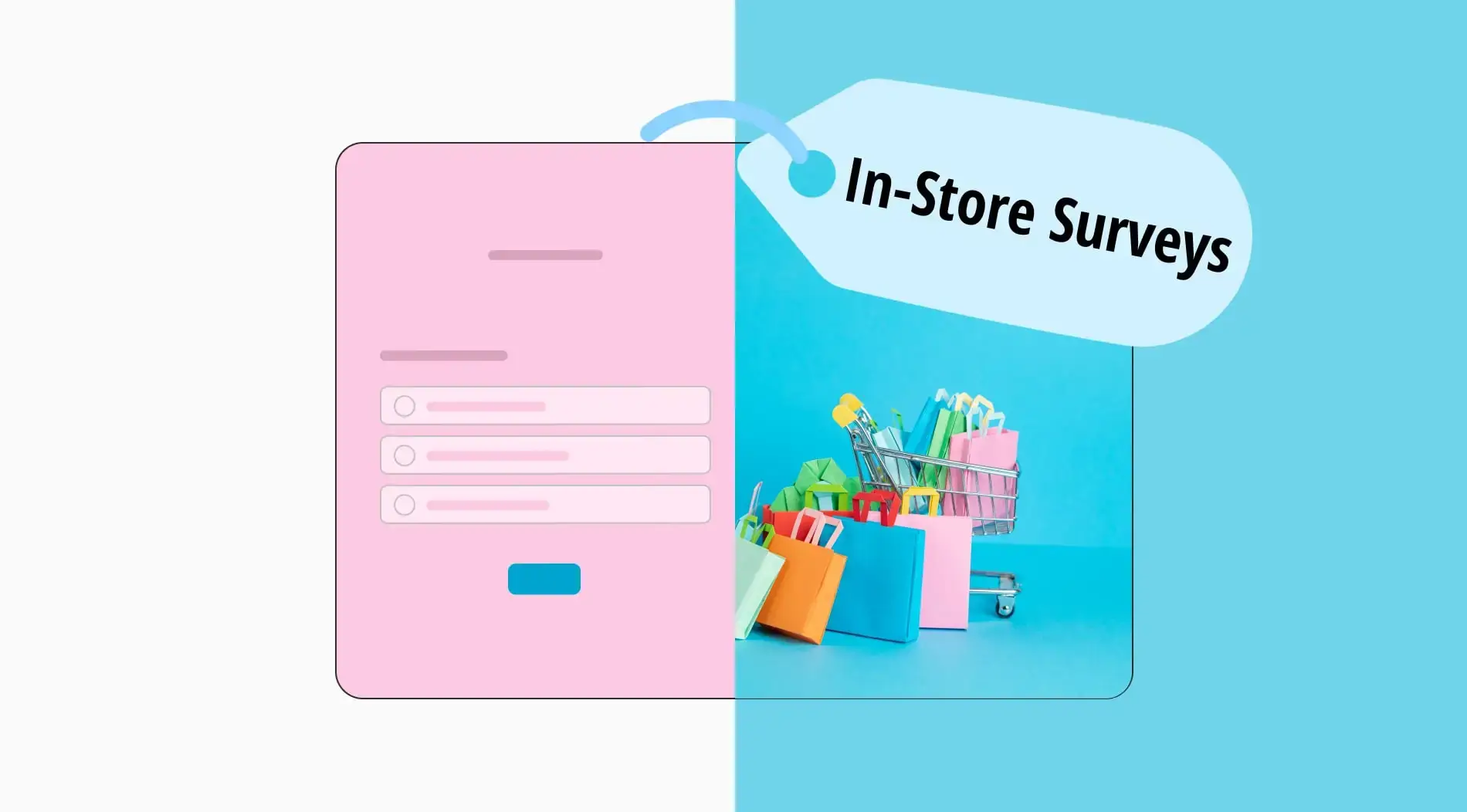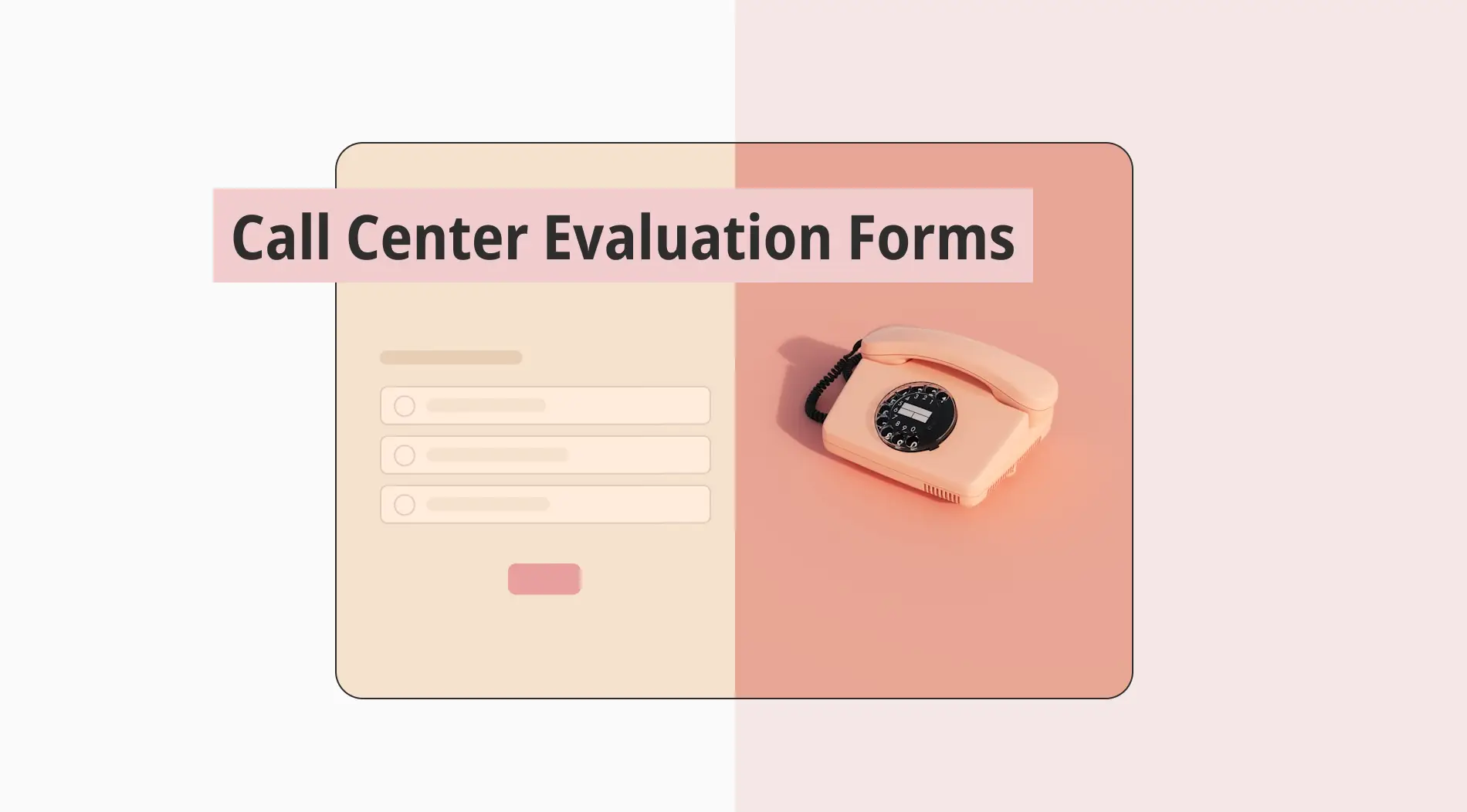Are you looking for a strategy to increase customer satisfaction and improve the experience in your store? In-store surveys can be a game-changing method. Whether you're an experienced business owner or just starting, taking advantage of store surveys is a great way to make your business successful.
What is an in-store survey, and how do you create it? Why do businesses use in-store study? Which questions can you ask, and why do you need to ask these questions? Continue reading and find the answers to all these questions and much more in this article we have prepared for you. You will also see tips on how to create an in-store survey. So, let's get started.
First things first: What is an in-store survey?
In-store surveys are valuable tools that allow you to evaluate your customer's experience with a retail business or store.
Through these surveys, you can obtain valuable information about your customer's overall shopping experiences, such as product selection, pricing, customer service issues, cleanliness, and store layout. The feedback you receive through the right questions allows you to make the necessary strategic improvements in the areas you determine regarding customer preferences and expectations. Thus, you can increase customer satisfaction.
Why to use an in-store survey for your business
To make your business successful, you must first understand your customers' shopping experiences, expectations, and needs. You should also develop strategies to meet these needs. There are many reasons why companies need and prefer these surveys. Look at these critical reasons and create a more effective in-store shopping experience:
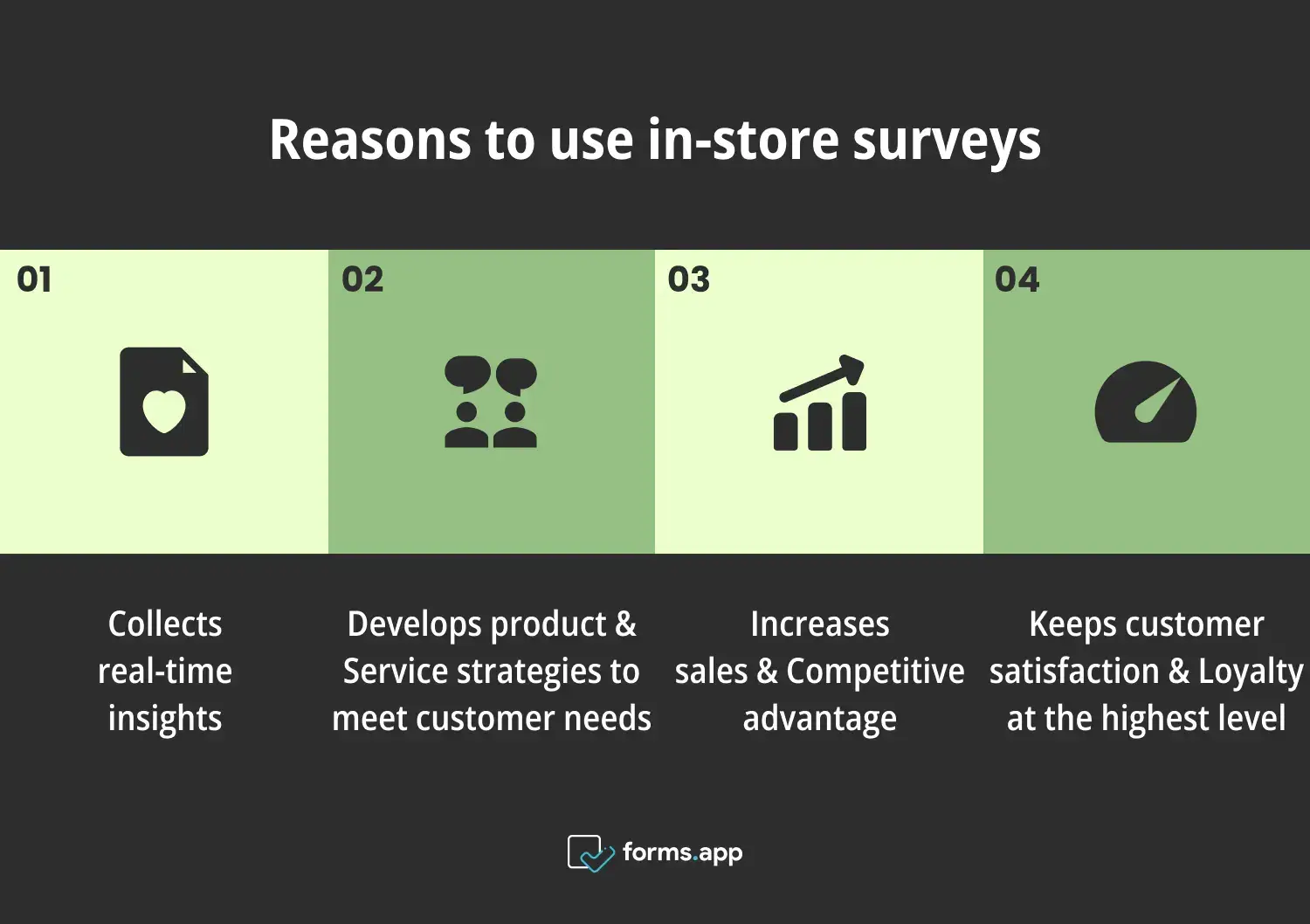
Advantages of using in-store surveys
- It allows you to collect real-time insights about customer experiences and provides more accurate information.
- You can develop product and service strategies to meet customer needs through direct questions about customer expectations and requests.
- It allows you to increase sales and competitive advantage by improving the shopping experience.
- It helps you keep customer satisfaction and loyalty at the highest level.
15+ Must-ask questions to ask in your in-store surveys
The questions you ask in the in-store survey and the answers you get accordingly help you improve the shopping experience and the effectiveness of your marketing efforts. In this regard, choosing the right questions plays an important role. Below, we have shared more than 15 in-store survey questions with alternative answer options that will increase the response rate and data quality:
1. How likely are you to recommend our store to a friend or family member?
It is a net promoter score (NPS) survey question that allows you to measure your customers' overall satisfaction levels. You can ask customers about the recommendability of your store using a scale from 0 to 10. The feedback you obtain reflects the customer loyalty and satisfaction your store creates. Thus, you can direct your strategies in a customer-oriented manner.
2. How satisfied were you with your in-store experience?
This question is a CSAT survey question to measure the overall satisfaction of your products or services. It allows you to evaluate your store's shopping experience and measure customer satisfaction. It will enable you to identify areas where your customers are dissatisfied, make necessary improvements, and increase customer satisfaction.
3. How easy was your in-store shopping experience?
The question that evaluates customers' interaction with the product and identifies current or potential challenges is the customer effort score (CES) survey question. It helps you assess your customers' difficulty and effort in areas such as finding what they are looking for, trying a product, making a payment, or taking post-purchase service.
4. Did anyone help you with your shopping experience?
This question, which you can ask about your customer's shopping experience, allows you to determine whether your employees are helping your customers throughout the purchasing process. By determining the areas where you need to improve in line with the results you obtain, you can carry out the necessary work and direct your employees' interest level.
5. Did you find our store staff helpful and attentive?
This question allows you to evaluate in more detail the level of engagement of your employees with your customers. By using feedback, you can determine your employees' work performance and increase customer satisfaction by making the necessary adjustments accordingly.
6. What challenges did you encounter during your store visit?
Asking your customers this question allows you to evaluate the adverse situations they experienced during the shopping experience. Thus, you can take precautions to eliminate these negativities based on the information you obtain. For example, if your customers complain about the complex store layout, you can provide a more straightforward, easier-to-understand store layout.
- Unhelpful staff
- Long checkout lines
- Difficulty finding products
- Poor store layout
- Lack of cleanliness
- High prices
- Limited parking
- Difficulty returning or exchanging items
- Unavailability of certain products
7. How would you rate the quality and variety of products available in our store?
This question can help you determine what your customers think about product variety and quality. Depending on the answers, you may supply higher-quality products to improve product quality. If the array is insufficient, you can also offer a more comprehensive range of products.
- Excellent
- Very Good
- Good
- Average
- Below Average
- Poor
8. How often do you usually shop from our store?
Through this question, you can evaluate your customers' perception of your store and their proximity to your store. You can offer quality products and services to increase your preferability so that people shop from your store more frequently.
9. How would you rate the cleanliness and order of the store?
Every customer wants a shopping experience in a clean and orderly environment. This factor also affects your customers' purchasing behavior. Nobody wants to shop in an untidy and unclean store. Based on your results, you should identify areas where your customers are dissatisfied with cleanliness and order and make the necessary improvements.
- Excellent
- Very Good
- Good
- Fair
- Poor
10. Did you think the prices in our store were reasonable for the products offered?
Determining whether prices are reasonable is a complex process that depends on the quality of the products and the customers' budget. However, this question can help you determine what your customer portfolio thinks about your pricing policy in line with their budget. Thus, you can develop efforts to convince them that your prices deserve the product quality or reconsider the pricing policy.
11. Would you like to receive updates and promotions from our store?
Customers tend to be loyal to stores where they have a positive shopping experience, and this situation is permanent. Therefore, they want to receive updates and promotions from stores. You can deliver updates and promotions to stay connected with your customers in various ways.
12. What would you like us to do in our store to improve your shopping experience in the future?
Through this open-ended question, you can allow your customers to talk about their shopping experiences without being limited to the areas you offer. Open-ended questions will enable you to obtain more comprehensive information. This way, you can learn about your customers' experiences in places other than what you offer.
13. Have you had any problems parking or accessing the store?
This question can help determine whether your customers need help parking and accessing your store. If they do, you can add follow-up questions to identify them and ask if you can do anything. Based on the feedback you collect, you can work to solve problems and provide assistance.
14. What do you like most about this store?
Using this question, you can identify areas where your customers' satisfaction rates are high regarding their experience with your store. It allows you to determine your business's challenges. Based on the results, you can develop strategies to highlight your strengths.
- The variety of products available
- The friendly and helpful staff
- The affordable prices
- The convenient location
- The clean and organized layout
- The quality of products
- The loyalty rewards program
- The online shopping experience
- The return policy
15. What are the top 3 things you don't like about this store?
Through this open-ended question, you can learn where your customers are dissatisfied. The feedback you obtain also allows you to identify areas where your business is weak. For example, suppose your customers are unsatisfied with your employees or their attitudes towards them. So you can make the necessary improvements, develop efforts to increase customer satisfaction, and eliminate your weaknesses.
How to create an in-store survey in seconds
You learned about 15+ in-store survey questions and why you must ask them in your in-store surveys. It's time to learn how to create an in-store survey using the forms app. Creating a survey is straightforward when you follow the proper steps. You can easily create your in-store survey by following the 6 steps below:
Step 1: Log in or sign up for forms.app
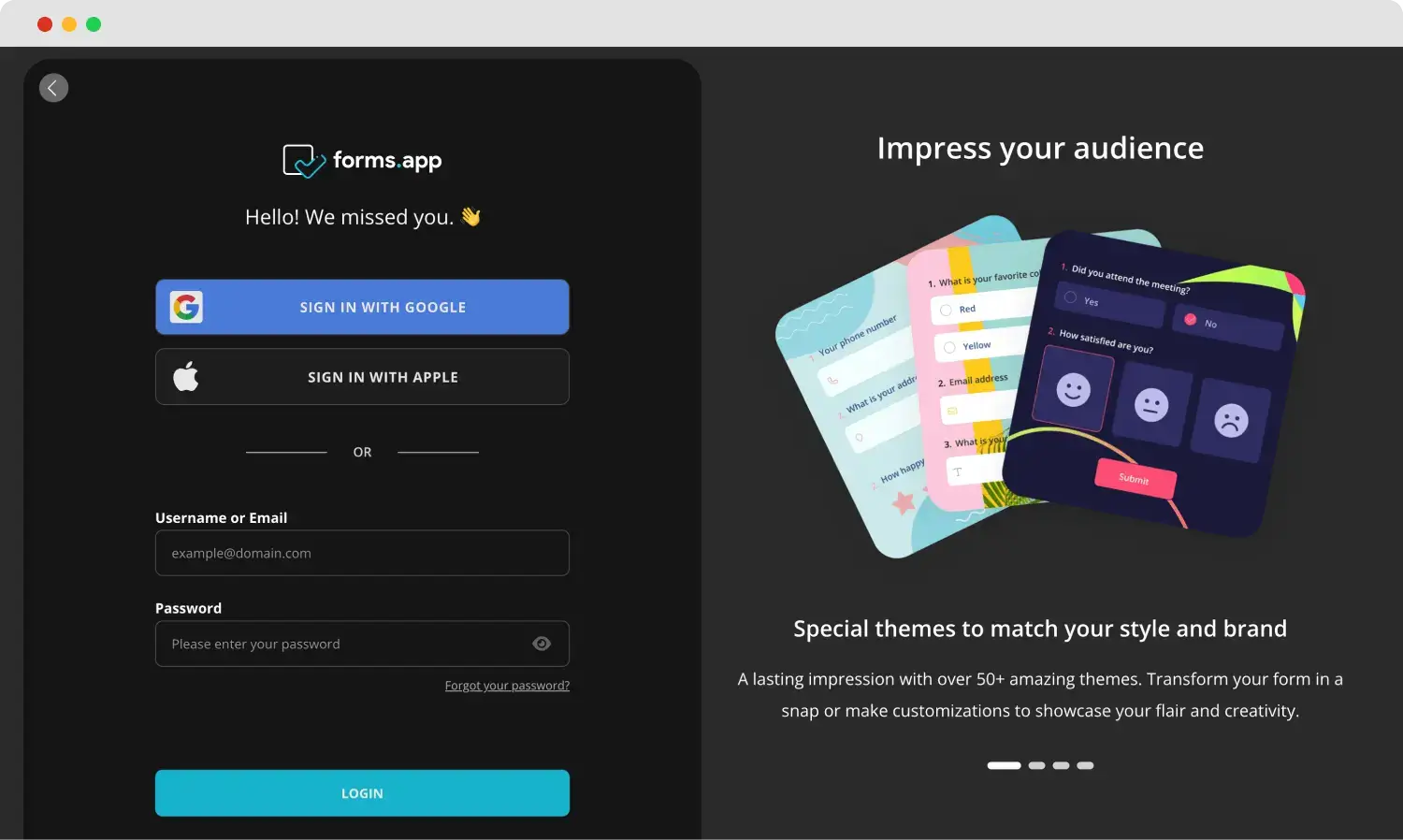
Login to your account
As a first step, you can create your in-store survey by signing up for an account using the forms app. You can create a free account in seconds if you don't have one. You can go directly to the platform if you already have an account. Apart from these, You can use your Google, Apple, or Facebook accounts to log in.
Step 2: Choose a template or generate with AI
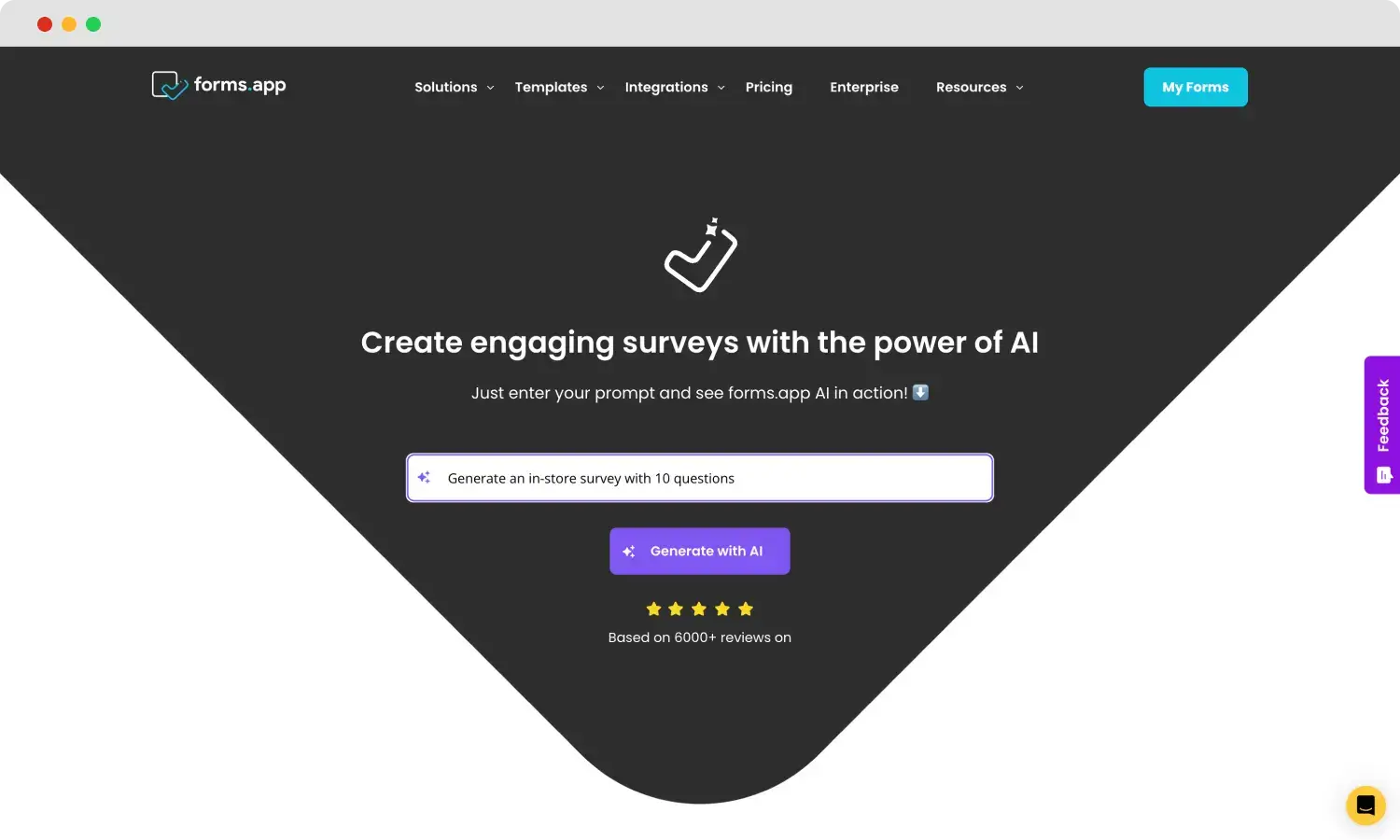
Generate your form with AI
Once you reach the dashboard, click the Create Form button and create your survey by creating a new form. You can also choose from ready-made survey free templates on the forms.app. You can create your in-store survey for free according to your goals. Also, you can get help from forms.app AI for creating your survey.
Step 3: Add your questions
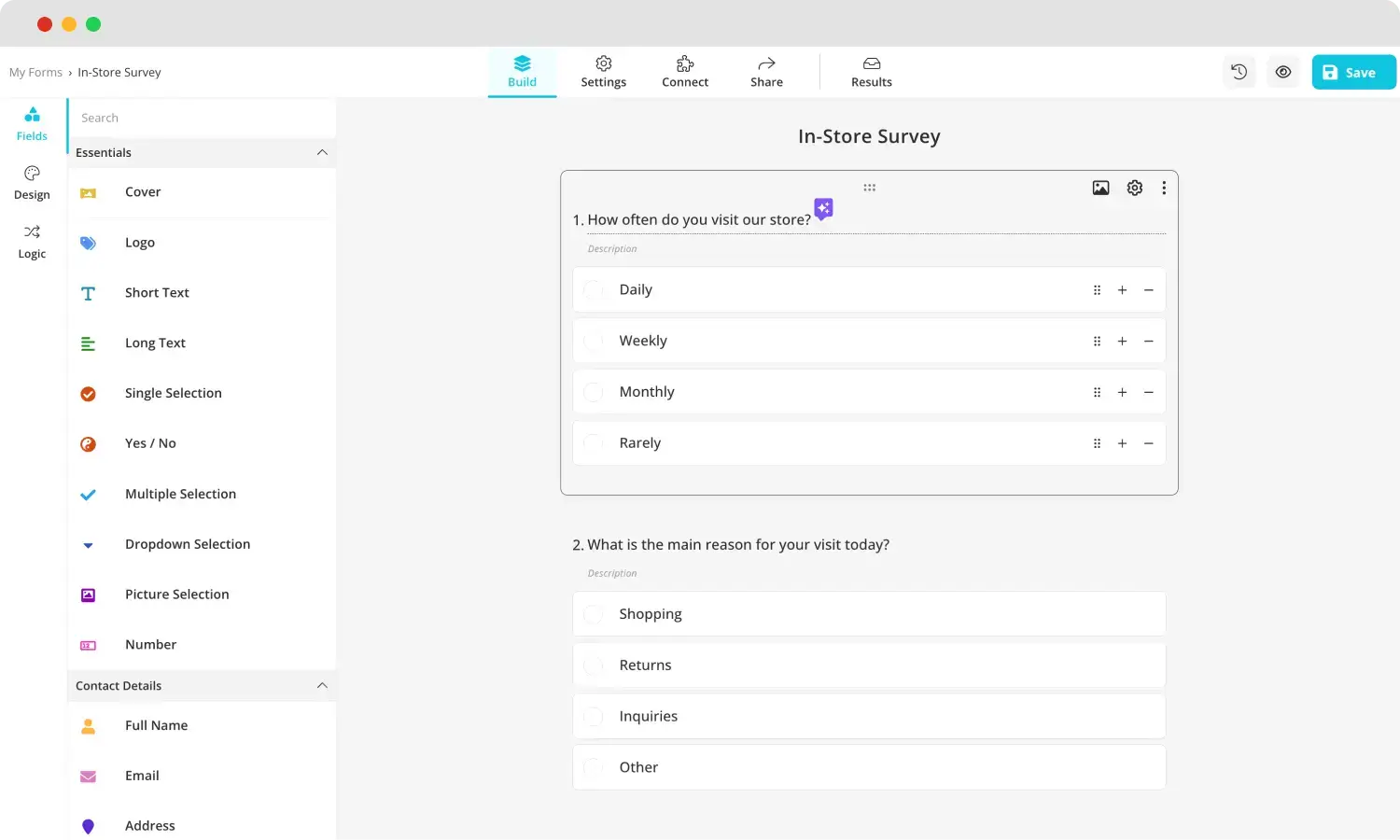
Add your in-store questions
You can add your in-store survey questions once you choose a template that fits your goals. Based on your goals, you can use the 15+ retail survey questions above in your survey. The forms app offers a variety of question types, such as multiple-choice, short-answer, and long-answer. Combining question types helps you better understand your customers' feelings and increases response rates.
💡You can also benefit from customer satisfaction survey questions to better understand your customers' experiences.
Step 4: Customize your form design
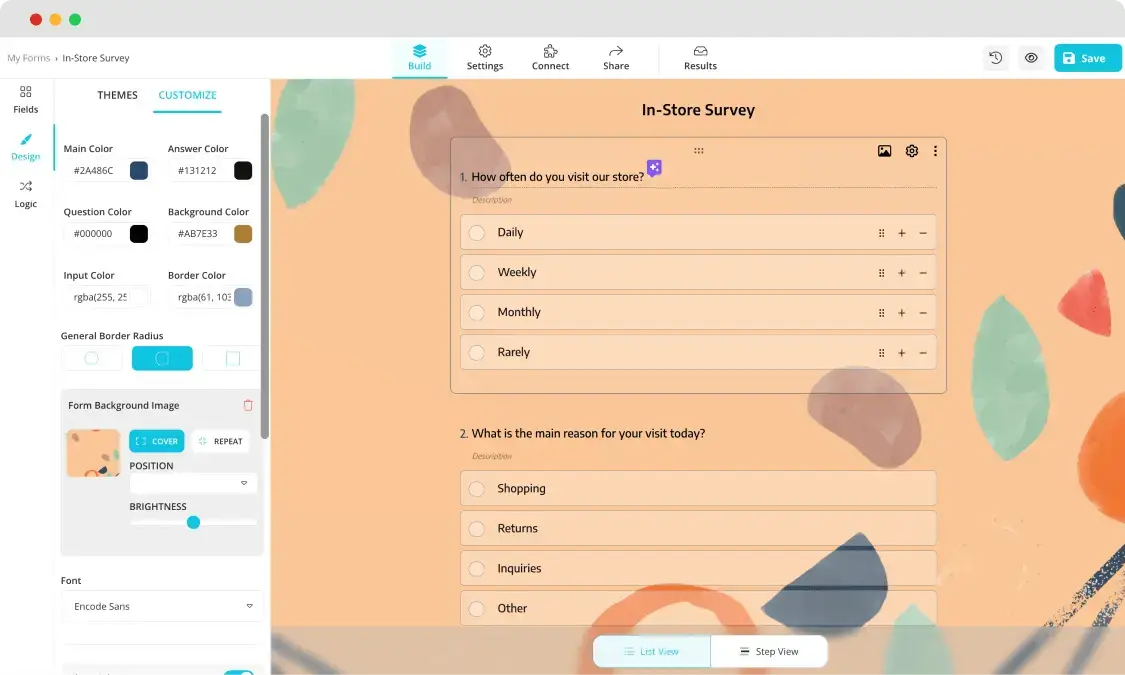
Customizing the design of your survey
Now that you've added your questions, it's time to design your survey. You can change the look of the survey as you wish. The design field offers many options for styling your survey. You can easily select a theme and change colors. You can also choose your form images, logo, and cover. You can tailor colors, fonts, and other overall design tools to create a survey that mirrors your company's identity company's.
Step 5: Share your survey
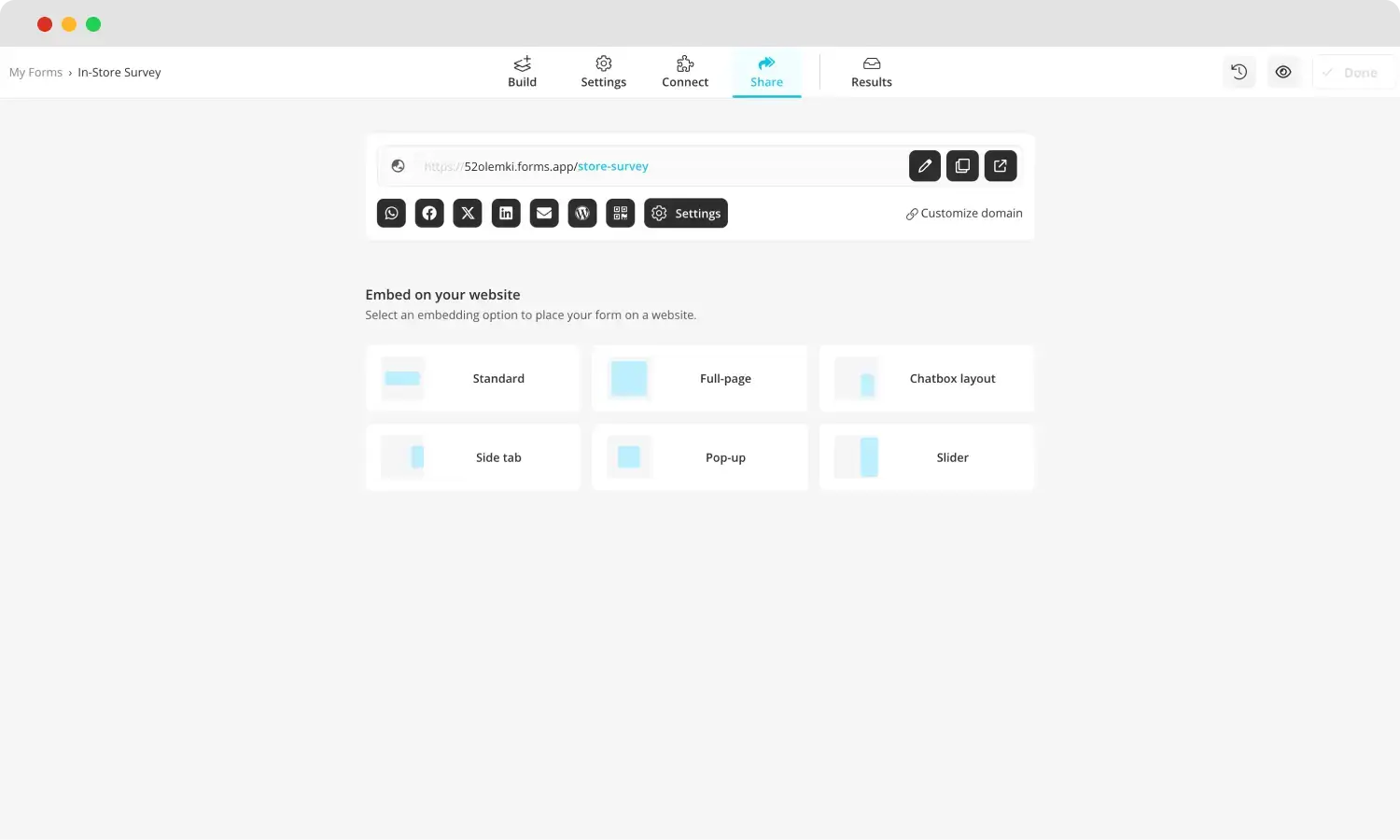
Share your survey
Once you design your survey, it is ready for you to share with your retail customers. You can conduct your survey online by sending your customers an email or text message invitation to participate in your online survey. You can also do so in person or through representative store staff.
You can also share your survey by placing tablets and kiosks in different areas of your physical retail stores. It allows you to gather real-time customer feedback in a retail store quickly. The checkout process and fitting room are the last touchpoints in the customer journey. Therefore, it is more likely that consumers' response rates will be higher during this wait time at checkout and fitting.
Step 6: Analyze your in-store survey results
Once you have gathered sufficient data, you can use the forms.app’s features, characteristics, and filters to analyze survey results. Also, you can benefit from customer feedback statistics when analyzing the in-store study results. Retail customer feedback lets you notice your shortcomings and reduce them or recognize the services or products you like.
5 Tips for in-store surveys
You can follow the steps and create a good marketing survey, but like any research study, an in-store survey has intricacies that you must address. Below, we include tips on creating a memorable questionnaire for retail store customers and increasing the rate at which customers respond to your survey:
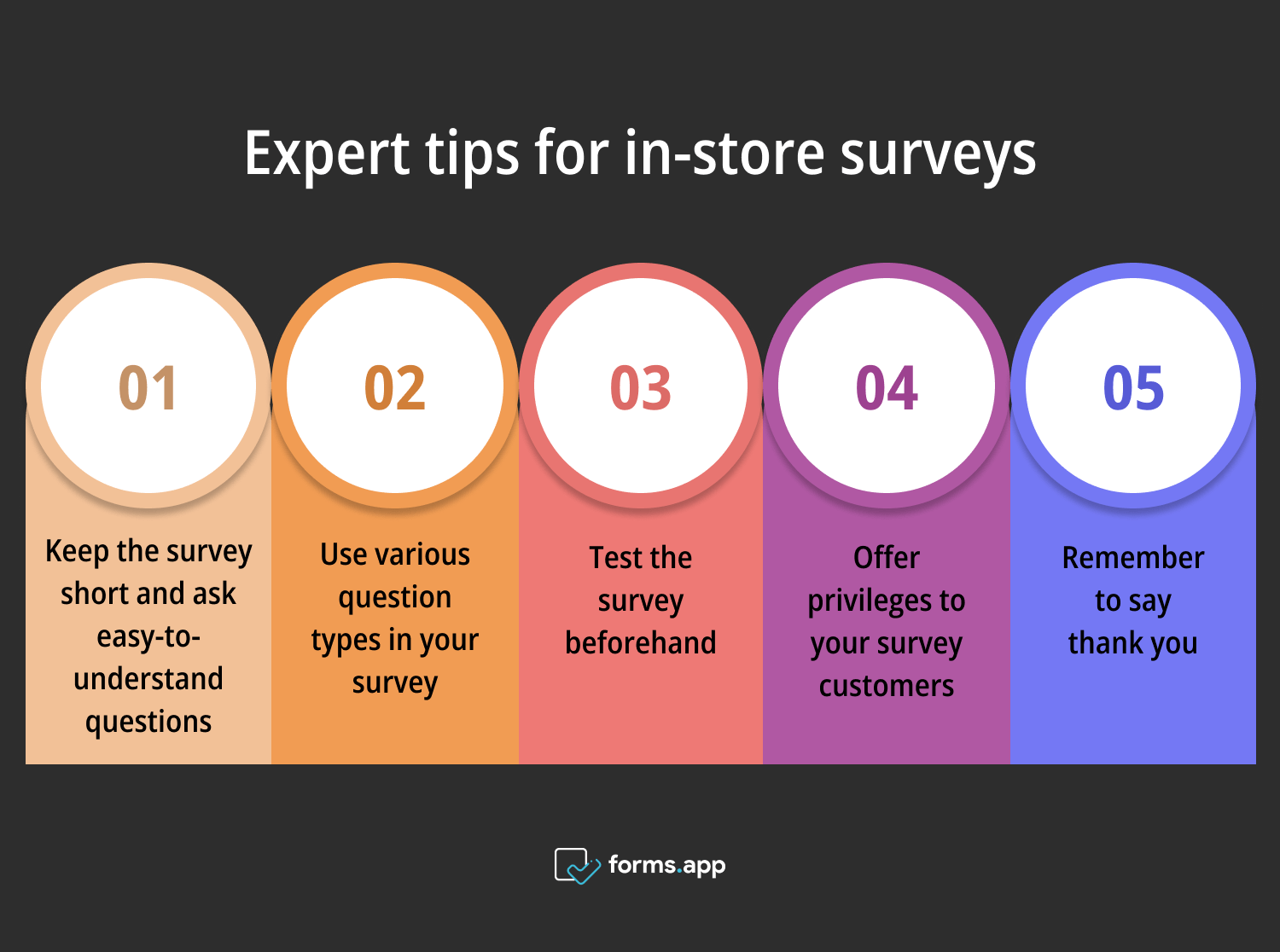
Pro tips for your in-store surveys
- Keep the survey short and ask easy-to-understand questions: No one likes filling out a twenty-minute survey. Therefore, a short, simple, and exciting survey can increase the participation rate.
- Use various question types in your survey: A mixture of closed and open-ended questions with understandable language can achieve more effective results, allow your participants to provide more comprehensive information, and increase productivity.
- Test the survey beforehand: You can pre-test your survey with a small group before presenting it to your primary audience. This way, you can improve your work with the survey results you get and, at the same time, identify and solve potential problems.
- Offer privileges to your survey customers: You can give privileges such as gift cards, discounts, and promotions to your customers who participate in the survey. It will increase response rates and make it easier to collect feedback.
- Remember to say thank you: To make your participants feel valued, thank them by emphasizing the importance of their contribution. This behavior will strengthen your brand image and make your customers feel good.
💡You can use the best survey features to improve your survey to make it more impressive and exciting.
Key points to take away
In-store surveys are one of the most effective ways to understand customers' experience in the retail environment. At this point, if you want to get an idea about the needs and expectations of your target market, start creating an in-store survey immediately and find out how your customers experience your store quickly and in real-time.
In this article, we shared the definition of an in-store survey, how to create it, and tips about it. We aimed to inform business owners about 15+ in-store survey questions and why they need to ask them. We addressed jointly why companies or businesses need in-store surveys. Now that you have learned everything about in-store surveys, you can take action and start creating your own.
Işılay is a content writer on forms.app. She is passionate about advertising. This passion comes from the fact that she likes to make things interesting for people. She loves reading and writing. Işılay specializes in marketing, survey types, and program management.
